Venice Is a City Built on Sailing, and This Club Can Show You the Ropes
A group of idealistic young sailors is preserving Venice's bygone maritime traditions, and you can learn to sail alongside them.
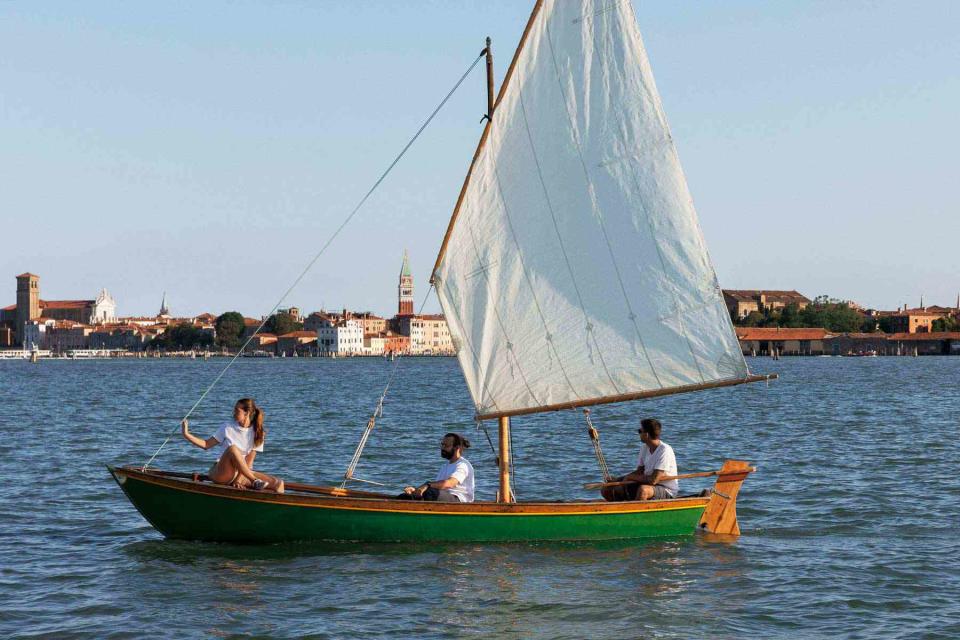
Camilla Glorioso
Sailing with Venice on Board.JUST TRYING TO find the office of the sailing and rowing club Venice On Board involves taking a deep dive into the maritime past of Italy’s most ravishing city. The club sits in the ancient boatbuilding district of Cannaregio, where the intricate maze of alleys and canals confounds even Google Maps. I discovered this one morning last spring, when I wound my way there from the Piazza San Marco, became lost, and had to retrace my steps several times before finally finding the Rio della Sensa, a dreamily quiet side canal near Venice’s last working shipyard. At 9 a.m., the only person in sight was a bearded young craftsman who was planing the hull of a traditional wooden sailing boat. Behind him, a heavy wooden door guarded by a sleeping brown dog stood open, leading me to deduce, Sherlock Holmes–style, that I had arrived at Venice On Board’s HQ.
The retro nautical ambience became even more potent when I peered inside to find what might have been a backstage prop room for a production of The Pirates of Penzance. Every inch of the floor was covered with coiled rope, canvas, obscure metal tools, and handmade models of antique Venetian sailing craft. Rows of oars were balanced in the ceiling rafters, and an entire wall was covered by wooden oarlocks called fórcole, which hung in racks like abstract sculptures; their designs have been honed over centuries to allow for a variety of rowing angles.
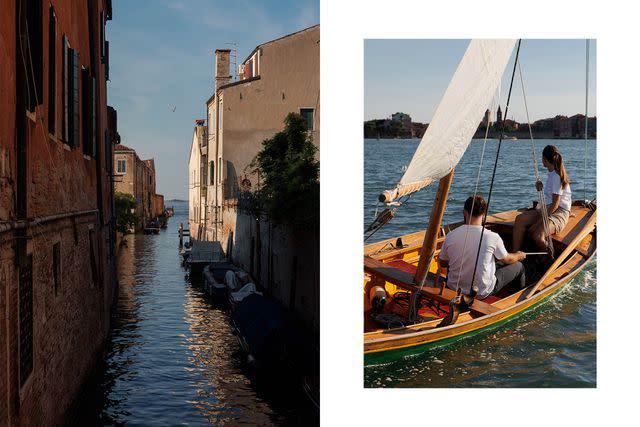
Camilla Glorioso
From left: A canal in the Cannaregio neighborhood that opens onto the lagoon; a lesson with Venice on Board, which teaches traditional rowing and sailing techniques.I had come here to take crash courses in two related arts: voga alla veneta, or Venetian-style rowing, and vela al terzo, sailing on Venice’s uniquely designed topi, small wooden boats that have been in use since the Middle Ages. Reclining behind a huge desk covered in marine charts was Emiliano Simon, a sun-bronzed, thirtysomething Venetian who was one of the club’s three original founders.
He explained that our morning lesson would focus on rowing, since no sailor in Venice can survive without it. “You need to know how to row in case the wind drops or you are becalmed in the lee of an island. You need to be confident you can get home!”
Related: The Five Best Hotels in Venice
A few minutes later, we were climbing onto the yellow-and-red-painted deck of an 18-foot topa. “I will teach you the first lesson to rowing in real Venetian style,” Simon deadpanned after he had dipped his oar and glided us to a gentle halt 100 yards away, below a café. “That is, we have an espresso! It’s very early.”
Sailing and rowing remained key parts of the waterlogged city’s daily life until the 1950s, when motorized boats began to replace them. The old nautical culture has all but vanished since.
WHILE WE CAFFEINATED, Simon explained why he had founded Venice On Board with his friends Nicola Ebner and Damiano Tonolotto in 2014. Although the trio hadn’t been raised in the city’s cultlike gondolier or fishing clans, they shared a passion for the water. They dreamed of restoring Venice’s seafaring heritage, which reached its apogee in the Renaissance, when the opulent Venetian Republic, or La Serenissima (“the most serene”), ruled a maritime empire that sprawled across the eastern Mediterranean.
Sailing and rowing remained key parts of the waterlogged city’s daily life until the 1950s, Simon went on, when motorized boats began to replace them. The old nautical culture has all but vanished since, he lamented: “There used to be more than sixty different styles of traditional rowing and sailing boats in Venice, and now there are fewer than fifteen. Most are just used for competitions these days. But they were once the only method of transportation in the city.” The creation of Venice On Board stemmed from more than simple nostalgia, he added. Motorboats offend many Venetians’ aesthetic sense: they create noise, and they churn up the mud at the bottom of canals, giving them their murky brown color. Rowers and sailors are more in touch with the environment. “It’s a different rhythm of life,” he said. “It’s a much more human pace.”
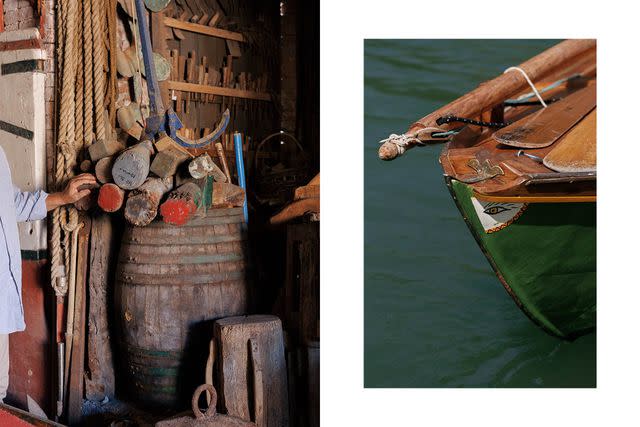
Camilla Glorioso
From left: Arzanà, a collection of boats and maritime artifacts in Cannaregio; one of the boats in Venice On Board’s fleet.The club’s primary goal has always been to reteach Venetian residents how to use traditional vessels. But in the past couple of years, Venice On Board has begun passing its skills on to curious visitors. This is a boon for independent travelers like me, providing a singular opportunity to explore the city—particularly the lagoon, the 212-square-mile enclosed bay that surrounds the urban core of Venice.
Separated from the Adriatic by thin barrier islands and spits of land, it’s the largest wetland in the Mediterranean—shallow, marshy, and challenging for outsiders to navigate alone. Of the lagoon’s 62 outer islands, only 14 can be reached by vaporetto, or water bus—and of those, only a few receive regular visitors, such as the beach-lined Lido and Murano, famous for its glassblowing workshops. That leaves dozens of islands that can only be reached by private boat, plus swaths of eerily beautiful coastal marshes fringed by pale purple wisteria and populated by colonies of silver herons and pink flamingos.
More Trip Ideas: Norfolk, England Is the Perfect Place for Sailing, Seafood, and Stately Homes
Accompanying me on this adventure was my girlfriend, Anna, who is Venetian and can trace her lineage back to one of the 16th-century doges who ruled the maritime republic and were wont to sail the lagoon in a gilded ceremonial barge. She offered to take me to the hidden bàcari, or bars, which she frequented as a philosophy student. In return, I shouldered the challenge of taking her to locales in her home city that she had never seen.
Many of the side canals have no footpaths and can only be explored by boat, so this was a rare chance to admire rusted gates that hid secret overgrown gardens, exquisite statues of boars’ heads lined up in rows, and ornately carved doorframes with stone steps descending to the water.
My first success was having found the ultimate aquatic base for us, the San Clemente Palace Kempinski Venice, located on a tiny private island in a former monastery with its own fresco-filled 12th-century church. Stepping onto its dreamy dock, only eight minutes by launch from tourist-filled Piazza San Marco, we already felt like we were entering an alternate dimension of calm and peace. The monks had excellent taste in real estate, we noticed. Every corner of the Kempinski’s centuries-old garden offers lavish water views, today enhanced by abstract artworks; within the church, marble cherubs danced above modern blown-glass sculptures by Venetian artist Lino Tagliapietra. And as we sat at an outdoor table to enjoy the sunset with an Aperol Spritz, the only sounds were the lapping of waves and cawing of seabirds. “Which sphere of Heaven is this?” Anna mused, referring to Dante’s Paradiso.
THE NEXT MORNING, while Anna visited the Venice Biennale—the international art fair the city hosts every other year from late spring to November—I sallied forth for my first lesson at Venice On Board. Our espressos happily consumed, Simon explained the art of rowing, which I broke into four movements that I repeated over and again to myself, like dance steps. Standing mid-deck with the oar’s ridged (“diamond”) side upward, I recited: “gira” (rotate the oar backward, “like revving a motorbike”); “spingi” (“dip” the oar); “taglia l’acqua” (“cut” the water with a smooth stroke); and “torna” (rotate the oar back to its original position as it exits the water). Meanwhile, Simon rowed and steered from the stern. (Traditional boats are powered by two or more oarspeople, as were gondolas until the late 19th century, when a new hull design allowed a single gondolier to both power and steer.) “You can get amazing results from a minimum of effort,” Simon said as I went through the four movements. “Remember, Venetians used to do this all day!”
Related: The Best Way to Enjoy Coastal Maine Is Aboard This Luxury Schooner
Resisting the urge to break into a rendition of “O Sole Mio,” I rowed down the Rio della Misericórdia while Simon guided us through a swarm of speeding water taxis and lumbering cargo barges. “It’s not like English rowing, in flat, calm lakes and empty rivers,” he noted. “In Venice you have tight turns and traffic jams.” The leisurely pace makes the activity a social event, I learned. As we passed under a bridge, Simon yelled out: “Nono!” Grandpa! He then paused to chat with his relative, a dapper silver-haired gent, about the menu for Sunday’s family lunch. “I was born and raised in Cannaregio,” Simon said.
But the hubbub subsided as we turned down a narrow side canal. In the silence, I was able to fully get into a rhythm. “It’s very meditative,” Simon said as we glided onward. I learned to yell out an “Oe!” at blind corners to alert other craft of our approach, followed by either premando (on the left, in Venetian dialect) or stagando (on the right). I also learned to look squarely ahead, instead of glancing at my oar as it dipped in and out, to better keep my balance. This allowed me to take in the marvelous architectural details of Venice’s palazzos at water level. Many of the side canals have no footpaths and can only be explored by boat, so this was a rare chance to admire rusted gates that hid secret overgrown gardens, exquisite statues of boars’ heads lined up in rows, and ornately carved doorframes with stone steps descending to the water. “These used to be the main entrances of the palazzos, since aristocrats would arrive by gondola. Now we use the servants’ entrance in the alley. Even Venetian people forget.”
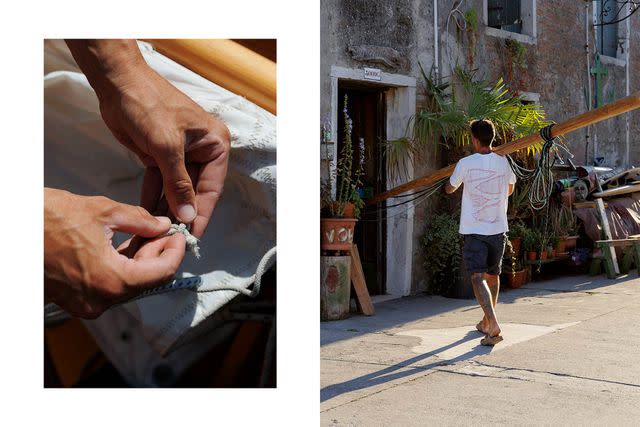
Camilla Glorioso
From left: Maneuvering the sail during a Venice On Board lesson; sailing instructor Emiliano Simon, a cofounder of Venice On Board.The relaxing old-world ambience suddenly vanished when we entered the Grand Canal, where the water was churning like a washing machine from all the motorboats. At one point, an ambulance vessel roared past, its siren blazing, sending enormous waves crashing over our bow and threatening to toss me over the side. “You are getting the full Venetian water experience today,” Simon said with a laugh.
“Congratulations!” he roared as we made it through the obstacle course. “You’ve crossed the Grand Canal for the first time!” It would be the first of many such journeys, he predicted.
FOR THE NEXT TWO DAYS, I practiced my Italian nautical phrases with Anna in our island monastery and tracked down such evocative sites as Arzanà, a private collection of maritime artifacts housed in a boatyard that operated from the Renaissance until 1920. It was crammed like an attic with wonderful memorabilia, including a rare gondoletta, or little gondola, made for two passengers.
By now, I was hooked on the water and itching to try my hand at sailing. Anna was keen to join me, and offered to translate the arcane nautical terms in Venetian dialect, which is almost as different to the official Italian I’d studied in college as French is to Spanish.
This time, the instructor would be another of the club’s founders, Nicola Ebner—a statuesque character who had worked as a glassblower on Murano before giving up his day job for life under sail. When we arrived at 9 a.m., Ebner was already loading up the topa with a mast and canvas. Our destination would be the abandoned island of Sant’Andrea, he declared, which was crowned by a ruined 16th-century military fortress and could only be visited by private boat.
The relaxing old-world ambience suddenly vanished when we entered the Grand Canal, where the water was churning like a washing machine from all the motorboats. At one point, an ambulance vessel roared past, its siren blazing, sending enormous waves crashing over our bow and threatening to toss me over the side.
We started rowing through the Cannaregio canals. Near the home of the 16th-century painter Tintoretto, we passed one of Ebner’s friends working on a broken outboard motor. “If you go rowing, the engine never breaks!” Ebner said, laughing, when the man yelled out for advice on how to fix it. (Ebner slowed down to explain that the problem was a blocked tube, which could be cleaned with wire.)
Pausing in the last canal, Ebner showed me how to transform the topa from a rowboat to a full-fledged vela al terzo sailing vessel, erecting the wooden mast, fitting ropes, and raising the sail, or terzo, a unique design with four uneven sides that can catch every breath of wind. The craftsmanship was superb: the handmade pieces fit together perfectly, like in a model aircraft kit. And then the canvas filled, the mast gave a creak, and we were gliding into the open waters of the lagoon.
It was an exhilarating moment. After the labyrinth of urban waterways, the sky of the lagoon seemed as vast as Texas. Luxuriating in space and sunshine, Anna sang an old Venetian folk song between two courting lovers: “Marieta, jump in the gondola. I’ll take you to the Lido!” says the young man, to which the object of his affections teasingly replies, “I don’t trust you! You are too much of a scoundrel.”
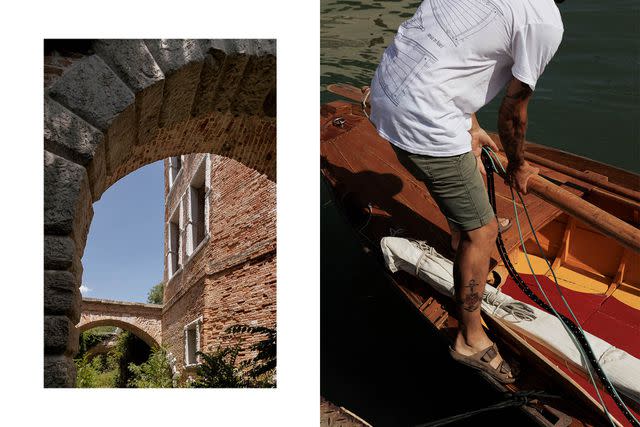
Camilla Glorioso
From left: The fortress on Sant’Andrea, an abandoned island accessible only by private boat; Simon rigs a boat with mast, sails, and ropes before a class.Ebner quickly taught us the basics of how to angle the canvas and rudder to regulate speed and direction. Unlike on modern yachts, he explained, tightening the sail brought the prow into the wind, while letting it out brought the wind behind and increased our velocity. He directed me to hold the tiller and sailing rope in the same hand, adjusting both to ease us across the mirror-flat, silver-blue waters. “Look, we are going beyond the briccole,” Ebner noted with satisfaction as we sailed past the wooden poles lashed together that mark the “lanes” dredged for motorized boats.
About 90 percent of the lagoon is less than six feet deep—some parts are barely two feet—which is why Venetian sailboats were designed with flat-bottomed hulls and removable rudders, so they could range freely. But sailing vela al terzo is also possible in the wild waves of the Adriatic and beyond, Ebner explained; in fact, the founders sail a topo (a larger version of a topa) to Croatia every summer, a weeklong journey where they all sleep on deck.
More Trip Ideas: 13 Affordable Places to Visit in Europe
As we relaxed into the trip, enveloped in silence, Anna helped me hone my vocabulary—learning about la popa, the stern, and la prua, the prow, and sailing sottovento (below the wind) versus sopravento (above it). She recalled an old Venetian expression used by her mother: “Sottovento via!”—loosely, “get under the wind and go,” moving quietly so nobody notices.
An hour later, we approached our goal, Sant’Andrea. There were no docks or even ladders, so we tied up beneath a stone balustrade and scrambled up to dry land. The fortress has been disused for a century and the island is now as wild as a national park. It felt haunted: Ebner led us along an overgrown path bristling with thorny bushes, under crumbling arches and up a worn stone stairwell, an ascent without guardrails that was not for the vertiginous. We finally clambered onto a bastion that once gave the republic’s cannons a commanding range over the lagoon’s entrance. Carved into the wall was the Lion of Saint Mark, the symbol of Venice. Today, I had to admit, the bastion would be a marvelous spot for a bar.
As we skimmed across the waves of the lagoon in the warm spring sunshine, it was impossible not to dream.
Ebner’s face darkened. As it happens, the future of the island is under debate, and Venetian residents worry that access will soon be limited. Earlier, we had passed an island that was sold to a private owner and today operates as an exclusive yachting club. “We Venetians all used to go there as teenagers for picnics and parties,” he lamented. “It is still supposed to be open to the public, but the reality is that if you land there, they will chase you away and threaten to call the police.” Locals hope that Sant’Andrea will escape that fate and instead be turned into a park that all can enjoy, “with a bar here, sure, but a bar everyone can visit!” Ebner sighed: “I’m not optimistic.”
This melancholy note was forgotten the moment we were back under sail, once again becoming part of Venice’s colorful nautical society. Within minutes of casting off, an elderly character in hunter’s camouflage pulled alongside us in a motorized dinghy filled with fishing rods. “How much did that sail cost you?” he yelled out. When Ebner told him, the man revealed himself to be Giovanni Naccari, one of only two traditional sailmakers still working in Venice. Our sail had been made by his competitor, but Naccari took the news with good cheer. “It’s still a good-looking sail!” After complaining about his luck with the morning’s fishing (“It’s lunchtime but I didn’t catch a thing. In fact, I almost got a ticket from the water police for fishing in the wrong place!”), Naccari then declared that he wanted to sell Ebner a traditional boat that he no longer used. The pair exchanged numbers, and then Naccari sped off.
“This could be good news,” Ebner said. “It’s a good price.”
The meeting inspired him to muse about Venice’s future. “This city could be the world leader in environmental sustainability,” he enthused. “We could all just go around Venice by oar, two or three people in a traditional rowboat. It can be faster than a vaporetto, without creating pollution of any kind!” It’s a wildly utopian vision—a bit like the idea of closing Manhattan off to all but bicycle traffic—but as we skimmed across the waves of the lagoon in the warm spring sunshine, it was impossible not to dream.
The Floating City
Where to Stay
San Clemente Palace Kempinski Venice: There’s no better way to experience the scale of the lagoon than with a stay at this luxe 196-room-and-suite resort on a private island. Guests can transfer to the Piazza San Marco via a fiveminute boat ride.
What to Do
Arzanà: A private museum of boats and memorabilia related to Venice’s nautical history. By appointment only
Venice On Board: Individual lessons in Venetian style rowing and private and group classes in sailing vela al terzo are held throughout the year through this association dedicated to keeping the city’s maritime traditions alive.
A version of this story first appeared in the February 2023 issue of Travel + Leisure under the headline "A Sailing Song."
For more Travel & Leisure news, make sure to sign up for our newsletter!
Read the original article on Travel & Leisure.

